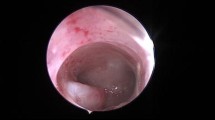Abstract
Objective
To estimate prevalence of malignancy and dysplasia in cervical polyps and to judge whether cervical polyps need to be removed routinely. Also to investigate if a cervical polyp is an indicator of endometrial pathology and to assess the necessity of performing dilatation and curettage (D&C).
Materials and methods
We retrospectively reviewed hospital records of 4,063 cervical polyp cases. Patients’ age, menopausal status and pathological findings were recorded. Descriptive statistics, Pearson’s χ2, Fisher’s exact test were used for statistical analysis. P value of ≤0.05 was accepted significant.
Results
Among 4,063 cervical polyps, only 3 (0.1%) cases of malignancy were encountered which were metastasis from endometrium. There were also dysplastic (0.4%), metaplastic (2.1%), inflamatory (1%) changes. Accompanying endometrial pathologies were: endometrial cancer (0.3%), hyperplasia without atypia (1.3%), endometrial polyp (6.6%). There was statistically significant relation between menopausal status and malignancy of cervical polyps (P = 0.055) malignancy of endometrial cavity (P = 0.0001).
Conclusion
Routine removal of cervical polyps, although not mandatory, seems clinically prudent because pathological evaluation is needed to confirm the diagnosis and to rule out other possibilities. 10.9% of postmenopausal patients and 7.8% of premenopausal patients were diagnosed with any endometrial pathology accompanying cervical polyp. Therefore, cervical polyps can be a sign of endometrial disease, especially in postmenopausal women with cervical polyp endometrium should be evaluated more carefully.
Similar content being viewed by others
References
Farra HK, Nedoss BR (1961) Benign tumors of uterine cervix. Am J Obstet Gynecol 81:124–135
Aaro LA, Jacobson LJ, Soule EH (1963) Endocervical polyps. Obstet Gynecol 21:659–665
Golan A, Ber A, Wolman I, David MP (1994) Cervical polyp: evaluation of current treatment. Gynecol Obstet Invest 37:56–58
Vilodre LC, Bertat R, Petters R, Reis FM (1997) Cervical polyp as risk factor for hysteroscopically diagnosed endometrial polyps. Gynecol Obstet Invest 14:191–195
Schnatz FP, Ricci S, O’Sullivan DM (2009) Cervical polyps in postmenopausal women: is there a difference in risk? Menopause 16(3):524–528
Israel SL (1940) A study of cervical polyps. Am J Obstet Gynecol 39:45–50
Berzolla CE, Schnatz PF, O’Sullivan DM, Bansal R, Mandavilli S, Sorosky JL (2007) Dysplasia and malignancy in endocervical polyps. J Womens Health 16:1317–1321
Stenchever MA, Droegemueller W, Herbst AL, Mishell D (2001) Comprehensive gynecology, 4th edn. Mosby, St. Louis, pp 492–493
Tweeddale DN, Gortey RL, Harvey HE, Tanner FH (1953) Cervical vs. endometrial carcinoma: the relative incidence of cervical carcinoma and endometrial carcinoma. Obstet Gynecol 2:623–628
Mezer J (1942) Metaplasia and carcinoma in cervical polyps. Surg Gynecol Obstet 75:239–244
Hill EC, Pernoll ML (eds) (2002) Current obstetric & gynecologic diagnosis & treatment, 8th edn. Appleton & Lange, Noralk, pp 726–727
Coeman D, Van Belle Y, Vanderick G, De Muylder X, De Muylder E, Campo R (1993) Hysterescopic findings in patients with cervical polyp. Am J Obstet Gynecol 169:1563–1565
Neri A, Kaplan B, Abinerson D, Ovadia J, Braslavsky D (1995) Cervical polyp in menopause and the need for fractional dilatation and curettage. Eur J Obstet Gynecol Reprod Biol 62:53–55
Selim MA, Shalodi AD (1985) Benign disease of the uterine cervix. Postgrad Med J 78:141–146
Hendricks CH (1955) Polyps: symptom of cancer? Obstet Gynecol 5:726–727
Conflict of interest statement
None.
Author information
Authors and Affiliations
Corresponding author
Rights and permissions
About this article
Cite this article
Esim Buyukbayrak, E., Karageyim Karsidag, A.Y., Kars, B. et al. Cervical polyps: evaluation of routine removal and need for accompanying D&C. Arch Gynecol Obstet 283, 581–584 (2011). https://doi.org/10.1007/s00404-010-1405-5
Received:
Accepted:
Published:
Issue Date:
DOI: https://doi.org/10.1007/s00404-010-1405-5




